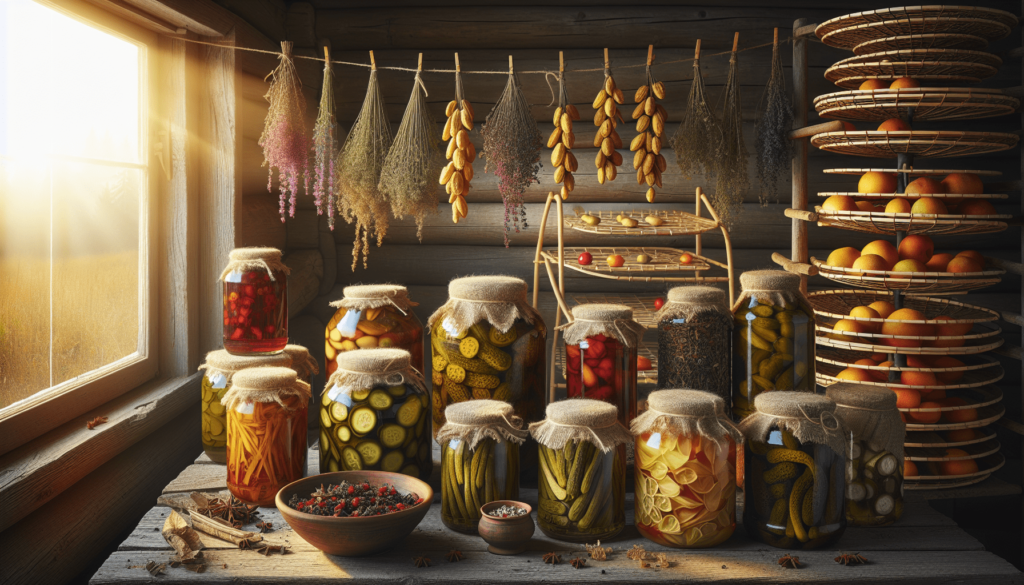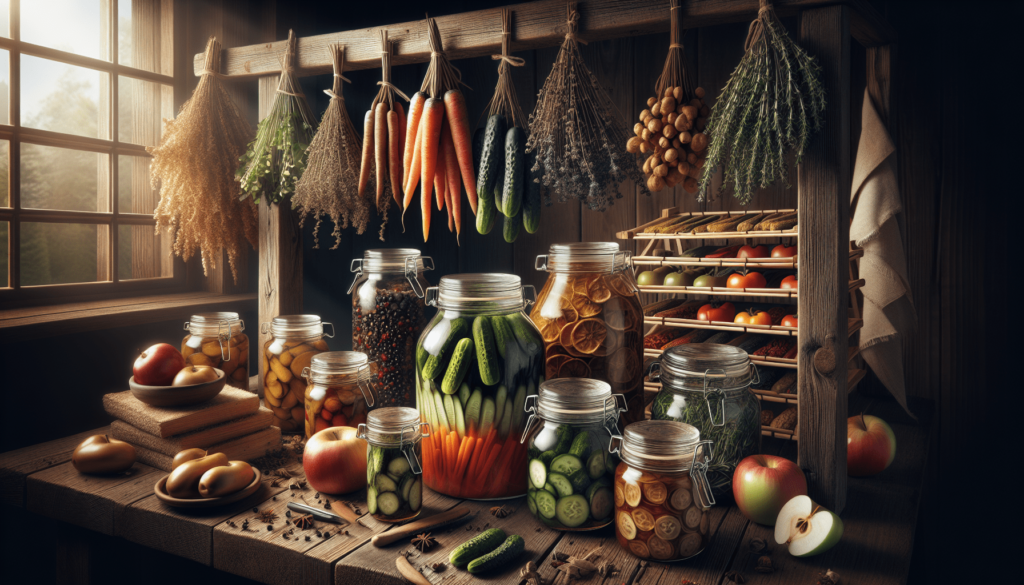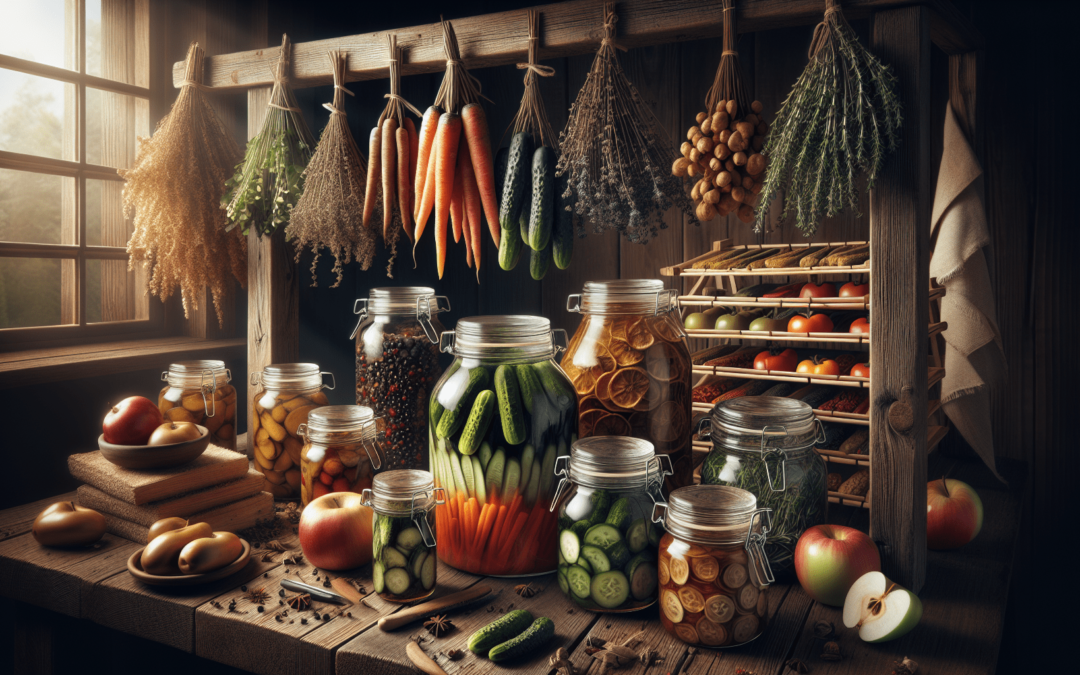Have you ever wondered how people managed to preserve their food before modern refrigeration and artificial preservatives? There’s a lot of wisdom to be gained from ancient practices. Preserving food without today’s technology can be a fascinating and practical skill to learn. Not only does it connect you to historical methods of survival, but it also offers sustainable ways to store food.

The Importance of Food Preservation
Before diving into the methods, let’s discuss why food preservation is so crucial. Food preservation was not just a choice but a necessity for survival. Without fridges, freezers, and fancy gadgets, people had to rely on nature and their ingenuity to ensure they had food available during harsh winters, dry seasons, or during times when food was scarce. In today’s context, understanding these methods can aid in emergency preparedness, sustainable living, and even enhancing the flavor of your foods.
Preventing Spoilage
The primary goal of food preservation is to prevent spoilage. This involves stopping the growth of bacteria, mold, and yeast which can make food unsafe to eat.
Extending Shelf Life
By using various preservation techniques, you can significantly extend the shelf life of your food, enabling you to store it for weeks, months, or even years.
Nutritional Benefits
Certain preservation methods can enhance the nutritional value of food, making them richer in vitamins and minerals, and sometimes even more digestible.
Various Primitive Preservation Methods
Drying (Dehydration)
Drying is one of the oldest and simplest techniques to preserve food. It removes moisture from food, making it inhospitable for microbial growth.
Sun Drying
Sun drying is effective in regions with low humidity and plenty of sunlight. It’s commonly used for fruits, vegetables, and meats.
- Preparation: Clean and cut food into thin slices.
- Application: Lay them out on a clean surface in direct sunlight.
- Protection: Use a fine mesh or netting to keep insects away.
- Duration: Let the food dry until it becomes brittle. This can take several days.
| Pros | Cons |
|---|---|
| Easy and natural | Weather dependent |
| No special tools | Takes time |
Air Drying
Similar to sun drying but done inside a well-ventilated area. It’s particularly useful in climates that are not consistently sunny.
- Preparation: Follow the same preparation steps as for sun drying.
- Hanging: Hang the food using string or place on racks.
- Air Flow: Ensure good air circulation.
- Duration: Dry until the food is brittle.
| Pros | Cons |
|---|---|
| Can be done indoors | Slower compared to sun drying |
| Good for larger foods | Requires sufficient air flow |
Smoking
Smoking is a two-for-one method where you cook and preserve food simultaneously by exposing it to smoke from burning wood.
Cold Smoking
Cold smoking involves exposing food to smoke at temperatures below 86°F (30°C).
- Preparation: Cure the food by salting or marinating.
- Setting Up: Place food in a smoker or an enclosed area with a smoke source.
- Duration: Leave for a few days up to several weeks depending on the food.
| Pros | Cons |
|---|---|
| Enhances flavor | Time-consuming |
| Great for fish, meat | Requires specialized setup |
Hot Smoking
Hot smoking both cooks and preserves food at the same time, usually at temperatures between 126°F to 176°F (52°C to 80°C).
- Preparation: Salt or marinate as in cold smoking.
- Cooking: Set the food in a smoker with higher heat.
- Duration: Smoke for several hours or until thoroughly cooked.
| Pros | Cons |
|---|---|
| Cooks and preserves food | Requires consistent heat control |
| Quicker than cold smoking | Needs a smoker or setup |
Fermentation
Fermentation is perhaps one of the most flavorful ways to preserve food. Bacteria, yeast, or fungi convert sugars and starches into alcohol or acids, which act as natural preservatives.
Lacto-Fermentation
This method uses lactobacillus bacteria which convert sugars into lactic acid.
- Preparation: Clean and chop vegetables. Place them in jars.
- Salting: Add non-iodized salt to create a brine.
- Fermentation: Leave at room temperature for several days.
| Pros | Cons |
|---|---|
| Boosts probiotics | Requires monitoring to avoid contamination |
| Enhances flavor/texture | Can be an acquired taste |
Salt Curing
Salt curing involves rubbing food with salt to draw out moisture, thereby inhibiting microbial growth.
Dry Curing
Food is coated with a dry curing mix, which usually consists of salt, sugar, and spices.
- Preparation: Clean and pat dry the food.
- Application: Rub a generous amount of curing mix onto the food.
- Storage: Place it in a cool, dry place.
- Duration: Leave it for several days or weeks.
| Pros | Cons |
|---|---|
| Effective for meats | High salt content might affect taste preference |
| Simple to do | Needs to be stored properly |
Sugaring
Sugaring is another method, similar to salt curing, that uses sugar to dehydrate food and inhibit microbial growth.
Dry Sugaring
Often used for fruits, this involves coating the food with sugar.
- Preparation: Clean and slice the fruit.
- Coating: Roll the slices in sugar or make a sugar syrup.
- Storage: Place in a container, ensuring it’s well coated.
- Duration: Let it sit for a few days.
| Pros | Cons |
|---|---|
| Enhances sweetness | High sugar content might be unhealthy for some |
| Easy to do | Attracts pests if not stored properly |
Burying
Burying food, particularly root vegetables, in cool, damp, earth can keep them fresh for extended periods.
- Selection: Choose hardy vegetables like carrots, beets, and potatoes.
- Preparation: Clean but do not wash them.
- Burying: Use a layer of straw, sand, or peat in a pit or container.
- Covering: Ensure the vegetables are completely covered and protected from pests.
| Pros | Cons |
|---|---|
| Effective for root vegetables | Not suitable for all food types |
| No special tools required | Requires proper pest control |
Pickling
Pickling involves preserving food in an acidic solution, such as vinegar, which prevents bacterial growth.
- Preparation: Clean and slice the vegetables or fruits.
- Brine: Create a solution of vinegar, water, salt, and sugar.
- Immersion: Submerge the food in the brine.
- Storage: Store in sterilized jars.
| Pros | Cons |
|---|---|
| Adds tangy flavor | Vinegar’s sour taste may not appeal |
| Versatile | Requires sterilized containers |
Root Cellaring
A root cellar is an underground storage room that maintains a consistent cool temperature, ideal for storing fruits, vegetables, and root crops.
- Location: Choose a spot with natural insulation and ventilation.
- Construction: Construct a cellar or use a part of your basement.
- Storage: Store food items in crates or shelves off the ground.
| Pros | Cons |
|---|---|
| Low-tech | Requires proper construction |
| Ideal for various crops | Limited by geographic conditions |
Practical Tips for Food Preservation
Cleanliness
Always begin with clean, sterile tools and containers to minimize the risk of contamination.
Storage Conditions
Ensure the storage conditions are optimal for the method you’re using. For example, a dry and dark place for dried foods, and a cool environment for root cellars.
Monitoring
Regularly check on the preserved food to ensure it’s staying in good condition. Look for any signs of spoilage such as mold, off smells, or discoloration.
Shelf Life Expectancy
Be aware of the shelf life of your preserved foods. While these methods can extend the longevity of food, they are not indefinite.
| Method | Estimated Shelf Life |
|---|---|
| Drying | Up to 1 year (if dry) |
| Smoking | Several months to 1 year |
| Fermentation | Several months |
| Salt Curing | Several weeks to months |
| Sugaring | Several months |
| Burying | Several weeks to months |
| Pickling | Several months |
| Root Cellaring | Several months to 1 year |
Conclusion
Having delved into these fascinating, historically-rich methods, you will realize how resourceful ancient civilizations were in securing their food supplies. Drying, smoking, fermentation, salt curing, sugaring, burying, pickling, and root cellaring offer a variety of ways to preserve different types of food. Each method has its unique benefits and challenges, making it suitable for different requirements and conditions.
By mastering these primitive methods, you empower yourself with the knowledge to manage your food resources creatively and independently. Plus, it’s a great way to deepen your connection with nature and learn the old ways that kept our ancestors thriving.
Are you ready to give one of these methods a try? Whether it’s drying your own fruit or setting up a root cellar, you’ll find the effort both rewarding and educational. Happy preserving!


